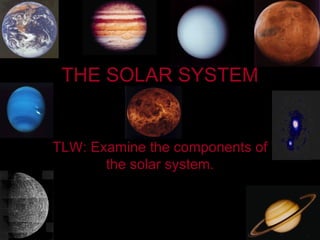
The solar system
- 1. THE SOLAR SYSTEM TLW: Examine the components of the solar system.
- 2. MERCURY Is about the same size as the Moon. Its mass (weight) is 1/20th that of the Earth. Its diameter is 2/5 that of our planet. Is the closest planet to the Sun. It is about 58 million kilometers from the Sun. Makes one complete orbit around the Sun every 87.97 days. Rotates on its axis very slowly compared to Earth. It completes one rotation in about 58 days and 15 minutes. Is covered with mountains, craters, ridges and valleys. Has no satellites.
- 3. VENUS *Is the closest planet to the Earth. It is about the same size as the Earth . *Is the brightest object in our sky, besides the Sun and Moon. *Is the second planet in order from the Sun. It is about 108 million kilometers from the Sun. *Makes one complete orbit around the Sun every 224.7 days. *Rotates on its axis more slowly than any other planet. It completes one rotation in about 243 days and 24 minutes
- 4. EARTH Is the planet that we live on, our planet. Is the third planet in order from the Sun. It is about 150 million kilometers from the Sun. Makes one complete orbit around the Sun every 365.27 days. Rotates on its axis about the same speed as Mars (just a little slower). It completes one rotation in about 23 hours and 56 minutes. Is mostly covered by water (75%). Has a total of 1 satellite (the Moon).
- 5. MARS Is sometimes called the Red Planet. Its mass (weight) is 1/10th that of the Earth. Its diameter is 1/2 that of our planet. Is the fourth planet in order from the Sun. It is about 228 million kilometers from the Sun. Makes one complete orbit around the Sun every 686.98 days. Rotates on its axis about the same speed as the Earth. It completes one rotation in about 24 hours and 37 minutes. Has seasons similar to our planet, but they last much longer. Has a total of 2 satellites (or moons ).
- 6. JUPITER Is the largest of all the planets. Its mass (weight) is over 320 times that of the Earth. Its diameter is over 10 times that of our planet. Is the fifth planet in order from the Sun. It is about 780 million kilometers from the Sun . Makes one complete orbit around the Sun every 11.86 years. Rotates on its axis faster than any other planet. It completes one rotation in about 9 hours and 50 minutes. Is one of the brightest planets . Has a total of 16 satellites.
- 7. SATURN Makes one complete orbit around the Sun every 29.46 years. Rotates on its axis at a very fast speed. It completes one rotation in about 10 hours and 39 minutes. Is known for the many rings that go around it. Is the second largest of all the planets. Its mass (weight) is over 95 times that of the Earth. Its diameter is over 10 times that of our planet. Is the sixth planet in order from the Sun. It is about 1.4 billion kilometers from the Sun.
- 8. URANUS Is composed mainly of hydrogen and helium gases. Its mass (weight) is over 14 times that of the Earth. Its diameter is 4 times that of our planet. Is the seventh planet in order from the Sun. It is about 2.9 billion kilometers from the Sun. Makes one complete orbit around the Sun every 84 years. Rotates on its axis about the same speed as the Neptune. It completes one rotation in about 17 hours and 14 minutes. Can sometimes be seen with the naked eye.
- 9. NEPTUNE Is very similar to Uranus in size. Its mass (weight) is over 17 times that of the Earth. Its diameter is 4 times that of our planet. Is the eighth planet in order from the Sun. It is about 4.5 billion kilometers from the Sun. Makes one complete orbit around the Sun every 164.79 years. Rotates on its axis about the same speed as Uranus. It completes one rotation in about 18 hours and 26 minutes. Has a weather system that is very active. Some storms with winds of 400 miles per hour have lasted for hundreds of years on its surface. Has a total of 8 satellites (or moons).
- 10. PLUTO Is the smallest planet. Its mass (weight) is 1/500th that of the Earth. Its diameter is about 1/6 that of our planet. Is the ninth planet in order from the Sun. It is about 5.9 billion kilometers from the Sun. Makes one complete orbit around the Sun every 248 years. Rotates on its axis slowly when compared to Earth. It completes one rotation in about 6 days and 9 minutes. Is sometimes known as a double-planet because it has a moon (Charon) that orbits it. Has a total of 1 satellite (or moons).